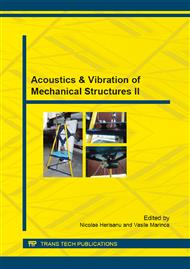p.242
p.249
p.257
p.262
p.267
p.273
p.278
p.284
p.290
Viscoelastic Behavior Simulation of Cortical Bone Tissues Using Burgers Rheological Model
Abstract:
The elastic properties of cortical bone tissue and other types of bone have been determined by the classical methods such as tensile stress and shearing stress. In recent years, by nanoindentation method, it has developed techniques for measuring the viscoelastic properties of bone tissues. In the same time, they show effects the dependent on time due to loading. The time dependent behavior of such viscoelastic materials may be described by constitutive equations whose variables are stress, deformation and time. These equations may be expressed by means of rheological models. Furthermore, bone tissues present both the phenomenon of creep and relaxation, indicating that they have a rheological behavior. In this paper viscoelastic behavior of bone is simulated numerically, and analyzed in Simulink, using Burgers rheological model.
Info:
Periodical:
Pages:
267-272
Citation:
Online since:
October 2015
Authors:
Price:
Сopyright:
© 2015 Trans Tech Publications Ltd. All Rights Reserved
Share:
Citation:


